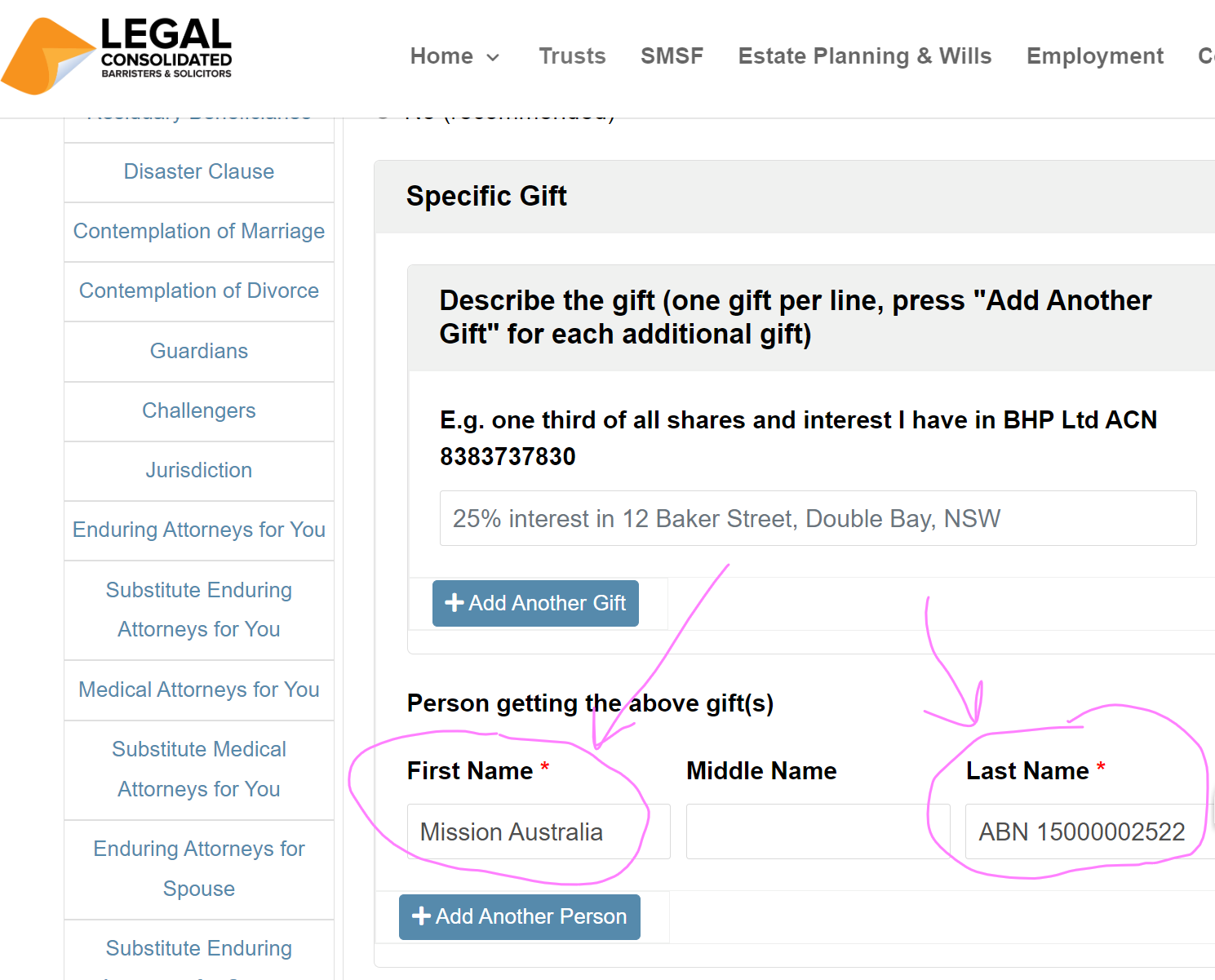At your death, binding death benefit nominations direct the superannuation fund to pay your superannuation and insurance benefits as set out in your nomination. The tax on superannuation at death is up to 32%. So your adviser will recommend putting a Superannuation Testematnntary Trust in your Will. But a Superannuation Testamentary Trust only works if you can direct your superannuation into your Will at death.
When can a POA sign a superannuation death benefit nomination?
The Court looked at a binding death benefit nomination Re Narumon Pty Ltd [2018] QSC 185. It confirms:
- that many Binding Nominations are faulty (but not for the reason we all thought);
- that it is safer to use a law firm’s website to build SMSF Deeds and Binding Non-Lapsing Death Benefit Nominations (Binding Nomination); and
- Those binding Nominations prepared on non-law firm websites are not protected by law firm Professional Indemnity insurance.
The peculiar case of Narumon [2018] QSC 185
John Giles starts an SMSF. John dies aged 80. He is survived by:
- his second wife (married 19 years)
- Nick – his child from his second wife (16 years old)
- four children from his first wife (one of his children is challenging his Will, but it only has $200k in it, but that is another story)
- his sister (sides with the second wife)
The second wife ends up as the sole director of dead John’s SMSF trustee company.
John’s superannuation had $4m:
- $1m – accumulation account; and
- $3m – lifetime complying pension.
John appoints his second wife and his sister to hold his Power of Attorney. Later that year he loses mental capacity.
At that time, John’s current Binding Nomination stated:
- 47.5% to the second wife
- 47.5% to his son Nick (from his second marriage)
- 5% to his sister (that is a bit strange since his sister is not a ‘dependant’ under the superannuation law).
John’s Binding Nomination ceased after three years. By that time John had lost mental capacity. John therefore could not sign a new Binding Nomination.
What went wrong in Narumon?
John’s SMSF Deed was prepared in 2013. However, it strangely required that all Binding Nominations expire after 3 years.
Can a Binding Nomination go longer than 3 years?
Binding death nominations are regulated by the Superannuation Industry (Supervision) Act 1993 (Cth). Sadly, the non-lawyer who prepared the Narumon SMSF Deed had only considered the legislation Reg 6.17A. The non-lawyer had not read the applicable Court cases.
What does Reg 6.17A state?
The legislation states that superannuation funds are forced to accept a valid Binding Nomination:
- Regulation 6.17A Superannuation Industry (Supervision) Regulations 1994 (Cth); and
- Section 59(1A) Superannuation Industry (Supervision) Act 1993 (Cth) (‘SISA’).
However, this is subject to Regulation 6.17A(7). This Regulation states that a Binding Nomination expires after three years.
But what do the cases say?
Consider Munro v Munro (2015) 306 FLR 93. It states that section 59(1A) SISA and Regulation 6.17A do not apply to Self-Managed Superannuation Funds (SMSF). Judge Bowskill in Narumon confirms this in paragraph 35:
“I agree with Mullins J’s conclusion in Munro v Munro at [35]-[36], that s 59(1A) of the Act does not apply to a self-managed superannuation fund”.
Section 59 states:
“(1) Subject to subsection (1A), the governing rules of a superannuation entity other than a self-managed superannuation fund must not permit a discretion under those rules that is exercisable by a person other than a trustee of the entity to be exercised… [italics inserted]
Bizarrely, the SMSF Deed needlessly forced the three-year expiration condition from Regulation 6.17A.
We see this often. Many non-law firm websites use badly drafted or out-of-date SMSF Deeds. The lawyers who handed over the template have long gone. Or there is no lawyer, to begin with. Even if there is a law firm providing the template, there is no law firm professional indemnity insurance applying to the template. In contrast, Legal Consolidated is a law firm. Legal Consolidated is responsible for documents built on our law firm’s website.
As a lawyer, I have sold over 18,000 SMSF Deeds online. Had John built his SMSF Deed on our law firm website he would have been able to get Binding Nominations that never expire.
Can a POA validate a Binding Nomination? The second wife and sister plot and plan

John’s second wife is frightened. She now knows that she and her son Nick are going to miss out on $4m. The second wife and John’s sister turn to John’s POA. Can they use the POA to freshen up the 3-year Binding Nomination?
The Court held that the document signed under John’s enduring attorneys was a valid Death Nomination. It complied with all the complex rules of binding nominations. Importantly, the Court noted it merely confirmed what John had already said in his now-expired death benefit nomination.
It was noted that the sister was getting 5% of John’s superannuation. But the sister was not a ‘dependant’ under the Superannuation rules. The sister did not want to money anyway. So the second wife and John’s sister used the POA a second time. They signed, on John’s behalf, a Binding Nomination of 50% to the second wife and 50% to her son. All they did was to remove the sister’s 5%. And the sister was happy with that. However, the Court found that the new Binding Nomination by the attorneys was invalid. It was a “conflict transaction” under the Powers of Attorney Act 1998 (Qld). It therefore required authority from John. (John is of unsound mind so that cannot happen.)
So it comes down to what is in the SMSF Deed and the relevant state POA. The law remains uncertain. This is often the case when Commonwealth law (SMSF) meets state law (POAs).
Can a superannuation fund accept a binding death benefit nomination signed under a power of attorney (POA)
The question of whether a superannuation fund can accept a binding death benefit nomination executed under a power of attorney (POA) was considered by the Supreme Court of Queensland in the case Re Narumon Pty Ltd [2018] QSC 185. The issues are:
-
Can a POA merely confirm the existing death benefit nomination?
The court found that an attorney (this is the person appointed under a power of attorney) could confirm an existing binding death benefit nomination under a POA. This action was deemed acceptable because it merely extended the duration of the deceased member’s previously expressed wishes, despite a potential conflict of interest.
-
Can a POA sign a new death benefit nomination?
However, creating a new binding nomination by an attorney was not permitted. The court viewed this as a “conflict transaction.” Since this involves making new decisions not previously authorised by the dead member. Therefore, it could conflict with the interests of the attorney, requiring explicit permission from the superannuation member, which is not possible as the member was of unsound mind.
-
Do different states’ POAs allow for the signing of death benefit nominations?
The Narumon decision turned on the specifics of the Queensland Power of Attorney Act and the trust deed of the particular superannuation fund involved, which in this case was a Self-Managed Super Fund (SMSF).
- Each Australian state and territory has its own laws governing POAs:
- Powers of Attorney Act 2000 (Tas)
- Powers of Attorney Act 1980 (NT)
- Powers of Attorney Act 1998 (Qld)
- Powers of Attorney Act 2006 (ACT)
- Powers of Attorney Act 2003 (NSW)
- Powers of Attorney and Agency Act 1984 (SA)
- Property Law Act 1969 (WA) and Guardianship and Administration Act 1990 (WA)
- Powers of Attorney Act 2014 (Vic)
- Only Tasmania explicitly mentions superannuation in its POA legislation. Therefore, the applicability of this decision to other jurisdictions or types of superannuation funds may vary.
- Each Australian state and territory has its own laws governing POAs:
-
Can the Superannuation Fund Deed reject a POA-signed death benefit nomination?
Many trust deeds expressly state that a binding nomination signed by a member’s attorney will not be binding on the trustee. This aligns with general legal principles that discourage potential conflicts of interest where personal benefits to the attorney might be seen to outweigh their fiduciary duties.
Superannuation Industry (Supervision) Act (SIS) regulations and general fiduciary duties also play crucial roles in determining whether a POA can sign a binding nomination.
In summary, while a POA can confirm an existing binding nomination under certain conditions, creating or altering such nominations where the interests of the attorney might conflict with their fiduciary duties or the original intentions of the member is generally not permissible without explicit authority, which must be compliant with both state and federal laws. Each case must be examined based on the specifics of the trust deed, the POA document, and applicable laws.
| Build these SMSF documents online |
|---|
| SMSF Deed – built over 18,000 times |
| Special Purpose Company – to be trustee of SMSF |
| Convert old Company into a Special Purpose Company – to be trustee of SMSF |
| Binding Death Benefit Nomination – updates the SMSF Deed as well |
| Investment Strategy – ATO audit friendly |
| Product Disclosure Statement – fully compliant with budget |
| Vesting Deed – closes down old SMSFs |
| SMSF Commercial Lease Agreement |
| SMSF Training Course – includes the SMSF Deed |
| Deeds of Variation – Change Trustees & Members, Update Deed for new SIS Laws, including Binding Nominations & PDS |
|
Update your SMSF Deed for: |
|
|---|---|
| Update Trustee – remove, replace, and add new Trustees | |
| Full Replacement Deed – update your SMSF Deed | |
| Binding Death Benefit Nomination – updates SMSF Deed as well | |
| Update Trustee, Member, and Full Replacement Deed | |
| Change SMSF name – no CGT or stamp duty issues | |
| Replace a lost SMSF Deed – no Court order required |
Protects from death duties, divorcing and bankrupt children and a 32% tax on super.
Build online with free lifetime updates:
Couples Bundle
includes 3-Generation Testamentary Trust Wills and 4 POAs
Singles Bundle
includes 3-Generation Testamentary Trust Will and 2 POAs
Death Taxes
- Australia’s four death duties
- 32% tax on superannuation to children
- Selling a dead person’s home tax-free
- HECs debt at death
- CGT on dead wife’s wedding ring
- Extra tax on Charities
Vulnerable children and spend-thrifts
- Your Will includes:
- Divorce Protection Trust if children divorce
- Bankruptcy Trusts
- Special Disability Trust (free vulnerable children in Wills Training Video)

- Guardians for under 18-year-old children
- Considered person clause to stop Will challenges
Second Marriages & Challenging Will
- Contractual Will Agreement for second marriages
- Wills for blended families
- Do Marriages and Divorce revoke my Will?
- Can my lover challenge my Will?
- Make my Will fair: hotchpot clauses v Equalisation?
What if I:
- have assets or beneficiaries overseas?

- lack mental capacity to sign my Will?
- sign my Will in hospital or isolating?
- lose my Will or my home burns down?
- have addresses changed in my Will?
- have nicknames and alias names?
- want free storage of my Wills and POAs?
- put Specific Gifts in Wills
- build my parent’s Wills?
- leave money to my pets?
- want my adviser or accountant to build the Will for me?
Assets not in your Will
- Joint tenancy assets and the family home
- Loans to children, parents or company
- Gifts and forgiving a debt before you die
- Who controls my Company at death?
- Family Trusts:
- Changing control with Backup Appointors
- losing Centrelink and winding up Family Trust
- Does my Family Trust go in my Will?
Power of Attorney
 Money POAs: NSW, VIC, QLD, WA, SA, TAS, ACT & NT
Money POAs: NSW, VIC, QLD, WA, SA, TAS, ACT & NT
- be used to steal my money?
- act as trustee of my trust?
- change my Superannuation binding nomination?
- be witnessed by my financial planner witness?
- be signed if I lack mental capacity?
- Medical, Lifestyle, Guardianships, and Care Directives:
- Company POA when directors go missing, insane or die
After death
- Free Wish List to be kept with your Will
- Burial arrangements
- How to amend a Testamentary Trust after you die
- What happens to mortgages when I die?
- Family Court looks at dead Dad’s Will

